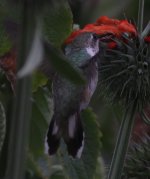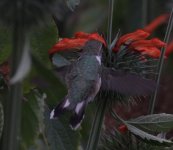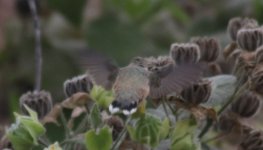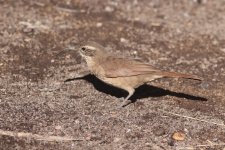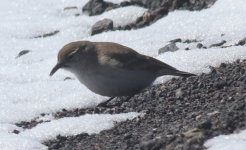opisska
rabid twitcher

I searched through every Polylepsis woodland around, but found no more Thick-billed Siskin candidates. What I did found though are other confusing birds 
1-3: Sanctuario de las Picaflores, Azapa valley. There was a lot of hummingbirds, but I haven't found any Chilean Woodstar males, so I had to turn into investigating females' tails, as that is the only real clue do differentiate those from Peruvian Sheartail females. I did indeed found these with weird tails, but those do not actually agree with the pictures in Jaramillo. So what are these?
4: This is a little below 3000 m a.s.l. in Socoroma. Jaramillo states that Plain-breasted Earthcreeper occurs above 3500, so by range this should be White-throated? But it was winter and snowy in the highlands, so I can feasibly imagine a puna species being pushed down. As for field marks, I can't really decide at all which one of those it is.
5: In the heights of Lauca, around 4500 m a.s.l., on the road waiting for snow to be cleared I found this, presumably a miner, but which? to be fair it looks best for Greyish to me, which would be however some 2 kilometers too high for its common range.
Thanks!
PS: I will make a report, because this was an interesting trip, but to tease, I actually found two Spot-winged pigeons (at very different locations), a species not even listed in Jaramillo!
1-3: Sanctuario de las Picaflores, Azapa valley. There was a lot of hummingbirds, but I haven't found any Chilean Woodstar males, so I had to turn into investigating females' tails, as that is the only real clue do differentiate those from Peruvian Sheartail females. I did indeed found these with weird tails, but those do not actually agree with the pictures in Jaramillo. So what are these?
4: This is a little below 3000 m a.s.l. in Socoroma. Jaramillo states that Plain-breasted Earthcreeper occurs above 3500, so by range this should be White-throated? But it was winter and snowy in the highlands, so I can feasibly imagine a puna species being pushed down. As for field marks, I can't really decide at all which one of those it is.
5: In the heights of Lauca, around 4500 m a.s.l., on the road waiting for snow to be cleared I found this, presumably a miner, but which? to be fair it looks best for Greyish to me, which would be however some 2 kilometers too high for its common range.
Thanks!
PS: I will make a report, because this was an interesting trip, but to tease, I actually found two Spot-winged pigeons (at very different locations), a species not even listed in Jaramillo!




